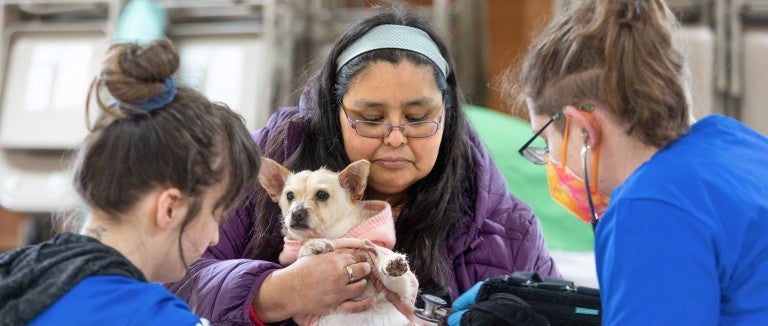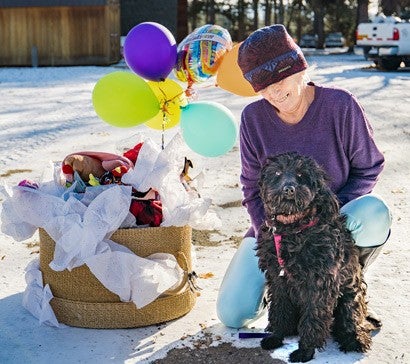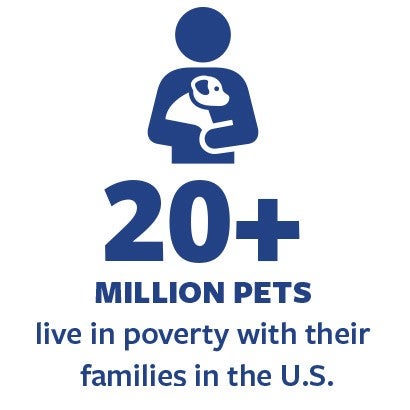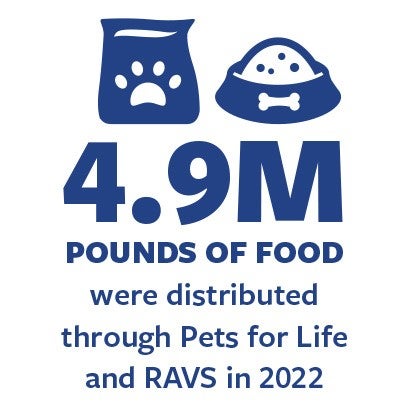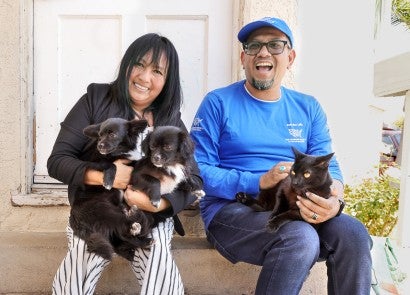In one sense, it was a “routine” grooming appointment. In November, a big poodle mix named Freeda got her curly black hair shampooed, cut and blow-dried to perfection. She went in looking good and came out looking better, ready to show off her new ’do to mom Janis at their Northern Idaho home. (Janis prefers to be identified by her first name only.)
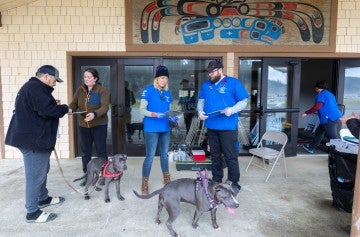
The same principle has informed the HSUS Rural Area Veterinary Services program since 2002. With a focus on Native communities, RAVS brings veterinary care to tribal lands with significant rates of poverty and unemployment—particularly rural ones. “They might be 50 or 100 miles away from the nearest veterinary practice,” says Windi Wojdak, senior director of RAVS. “So even if economic issues were on balance, the geography then adds another layer of transportation barriers.”
What sets RAVS apart is its teaching component. Each MASH-style spay/neuter clinic is staffed by volunteer veterinarians, veterinary technicians and veterinary students. The goal for students is twofold: to provide both hands-on training and experience with access-to-care issues.
It’s one thing to hear statistics, says Wojdak. It’s another to see barriers to care firsthand. “I don’t know how many times I have had students have true-life lightbulb moments,” she says. “That direct experience is absolutely life-altering.” Students often leave newly inspired to volunteer or work with under-resourced communities.
Helping pet, helping people
When we offer access to pet resources, says Arrington, “it’s not just an animal service, it is a human service.” The bonds between people and animals go deep, with proven benefits for human health: reducing cortisol (a stress hormone), lowering blood pressure, reducing feelings of loneliness and so much more—as anyone who has loved an animal knows. Helping people maintain those bonds by keeping them with their pets is a profound service.
But the issues Pets for Life and RAVS address don’t occur in a vacuum. Access to veterinary care, access to pet resources, a lack of pet-inclusive housing, “all of that is connected to larger systems of inequity,” says Arrington. “And because pets are part of families, it’s going to impact animals as well.” If a family struggles to purchase cat litter because they don’t have a car and public transportation is scarce, they’re not only struggling to care for their cat—they’re struggling with broader transportation and access issues.
It’s easy to oversimplify the problem, to suggest that “if we just have enough spay/neuter programs, the world will be OK,” says Wojdak. But asking why some communities don’t have veterinary clinics and why some communities have lower rates of altered pets can lead to some hard truths. Maybe those communities have historically been subject to racist redlining policies, leading to fewer investments in housing and resources. Maybe those communities have been left out of the animal welfare conversation, and they’re making the best decisions they can with the information (and resources) they have.
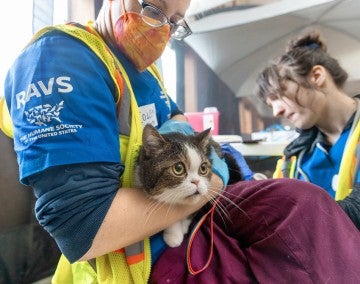
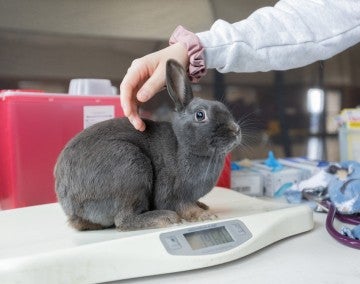
That nuance can get lost in discussions about access to care, especially within the animal welfare community, where emotions often run high. All too often, we forget that not everyone has the same background when it comes to animal care.
“There’s this assumption that everybody is operating from the same sheet of music,” says Tai Conley, HSUS senior principal strategist of diversity, equity and inclusion programs. It comes from a good place; we all love animals and want them to thrive. But what if pet care looks different across communities, and what if providing support ensures that a family can enjoy the companionship of an animal in the way that makes sense for them?
Animal welfare organizations’ actions tend to reflect a specific set of beliefs: that all pets must be adopted, immediately sterilized and cared for in a very specific way using very specific approaches. That attitude is often echoed on social media and elsewhere: If you can’t afford a pet, you shouldn’t have one. Pets for Life and RAVS challenge that assumption, asking us to broaden our understanding. Is it better to remove a pet from a home because her guardian can’t afford kibble at the end of the month, or is it better—for both pet and human—to connect her guardian with a pet food pantry, preserving their bond?
Taken to its logical conclusion, the argument about affordability suggests that only people with a certain socioeconomic status or living arrangement are worthy of having a pet, says Conley. And that “only exacerbates a problem versus creating solutions.” If you’ve ever tried to adopt a pet but been denied because you live in an apartment, or don’t have a fenced yard, or are “too old”—those are all access issues.
“Are we saying that euthanization is a better option than a loving home that just doesn’t have as much financial resource?” asks Conley. “Are we saying that these animals would rather be in unfamiliar environments like a shelter than with the families they’re familiar with?” And if the answer is no, what does it take to keep pets with the families who love them—and to offer the resources those families need?
Meeting people where they are
A story about a dog went viral this winter: A fluffy Great Pyrenees-German shepherd mix named Lilo was found wandering in Chattanooga, Tennessee, a handwritten note attached to her collar. “Please love me,” the note read. “My mom can’t keep me and is homeless with two kids. She tried her best but can’t get help. I cost too much for her. She really loves me and I’m a great dog and love to be loved on. Please don’t abuse me.”
A Good Samaritan brought Lilo to McKamey Animal Center, where staff saw Lilo for who she is: a beloved family member whose guardian was trying to keep her safe by making a painful decision. Rather than adopt Lilo into another family, the shelter—which runs a Pets for Life program—facilitated an emotional reunion with her owner. (Staff are helping the family find affordable, pet-inclusive housing.)
It’s worth asking how access-to-care issues affected Lilo and her family and what a more equitable system might look like. What if we made free pet food and supplies available? What if we offered temporary foster arrangements to people experiencing homelessness?
When we talk about access to care, affordability tends to dominate the conversation. Beth Aulwes, HSUS director of business partnerships, notes that many people facing poverty prioritize care for their pets. Pets for Life staff see it happen time and time again. “And that’s a conundrum we just don’t feel like anyone should have to face,” says Aulwes. Yet affordability is only part of the story.
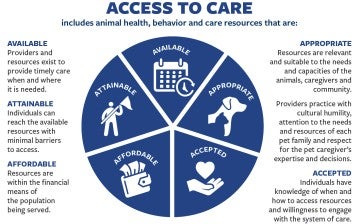
“The first thing that folks tend to think is that it’s all about economics, right? And that if it’s just affordable, if it’s free care, then it’s accessible,” says Wojdak. In reality, “access” is more complex. Building on principles used in human social services, the HSUS defines “access” as providing resources that are available, attainable, affordable, appropriate and accepted.
That nuance is critical, and it reflects the approaches taken by Pets for Life and RAVS. “Equity is about meeting people where they are to produce equal outcomes,” says Conley. It’s tailoring the approach to the community and avoiding judgment or preconceptions. It’s why the HSUS fights for access on multiple fronts, with policy experts advocating for pet-inclusive affordable housing and supporting the expansion of veterinary telemedicine.
We all come to the proverbial table with unique backgrounds and even willingness to engage with the animal welfare movement, says Conley. “Equity is the act of getting more people involved,” she says. “It’s the conscious practice of making this [movement] more accessible.”
In fact, “it is mission critical for us to do so,” she says. Giving people a solid foundation and emotional space to care for their pets is a powerful way to help animals and keep them in loving homes.
This year, the HSUS is expanding the conversation about pet equity with the More Than a Pet campaign, which launched in May. To honor the love people have for their four-legged family members, says Aulwes, the campaign showcases how the bond transcends race, ethnicity, geography and socioeconomic status while highlighting how an animal is indeed more than a pet. Its goal is to ensure programs such as Pets for Life and RAVS can continue doing what they’ve always done: nourishing the human-animal bond by ensuring people have what they need to care for their pets.
Both Wojdak and Arrington are hopeful about where this conversation can take us, not just as animal welfare advocates, but as people who care about other humans, too.
Arrington acknowledges that it’s easy to get impatient. “When you’re in the middle of it, it can seem slow,” she says, but stepping back offers perspective.
There’s been progress in the tenor of the conversation around these issues. Just a decade ago, says Arrington, almost everyone bought into the belief that if you can’t afford a pet, you shouldn’t have one. Pets for Life, with its nonjudgmental approach of simply meeting people where they are, was quietly radical.
“There wasn’t just a disagreement on the philosophy that Pets for Life was promoting. There was real pushback,” says Arrington. Naysayers suggested that Pets for Life would “enable” people who “shouldn’t” have pets, or that community outreach wasn’t safe, or that underserved communities were rampant with animal cruelty and fighting. These days, as conversations about equity have become louder, the naysayers have gotten quieter.
Change has been “so incremental that it’s easy to not see the progress,” adds Wojdak. But when she reflects on her 20 years doing this work, Wojdak does see it. Then, students joined RAVS primarily for the hands-on clinical experience. As for topics such as shelter medicine and access to care, “none of that was part of the conversation at all,” she says. Today, students learn about these issues in school.
Wojdak also sees progress in the types of issues RAVS addresses. She notices fewer preventable illnesses, such as canine parvovirus and sarcoptic mange, and she says more animals are receiving vaccinations and preventive care.
The change is worth celebrating. “When you look at how long animal shelters have been around and how long the humane movement has existed, for this part of the work to catch on as quickly as it has, I think it’s something that all of us collectively should give ourselves some credit for,” says Arrington.
What you can do
Creating an equitable world for people and pets requires more than just providing services. It involves reimagining our societies and supporting humans so they have what they need to provide safe, loving, comfortable homes for themselves and the animals in their care. Here’s how you can help.
Advocate for pet- and people-friendly policies in your community. Speak out against breed-specific legislation (the practice of barring people from housing if they have certain breeds of pets) and push for pet-inclusive housing policies. Let your legislators know you support affordable housing and other policies that increase equity. If you’re intimidated, remember that many community leaders have pets of their own—and connecting with them about a shared love of animals is a great way to start a conversation.
Get comfortable with discomfort. If you feel resistant to these ideas or are unsure how to talk about them, you’re not alone. Acknowledge the discomfort and let yourself sit with it. Have conversations that challenge you, and give yourself and others grace. “There are going to be moments where we say the wrong thing, we do the wrong thing, and I think as long as we are giving it our best effort and it’s genuine and authentic, we need to support each other through it,” says Amanda Arrington, HSUS vice president of access to care.
Support your local shelter or rescue. It’s a tough time for animal welfare, as the economic and societal issues affecting people ultimately affect their pets. Ask what local groups need: Is it funding? Donations of supplies? More foster families? The better resourced your local shelters and rescues are, the more they’ll be able to focus on the big work: supporting pet-friendly policies, providing pet food banks, working in their communities and building relationships to find out what pet owners need.
Want more content like this?
This was written and produced by the team behind All Animals, our award-winning magazine. Each issue is packed with inspiring stories about how we are changing the world for animals together.
Learn MoreSubscribe
